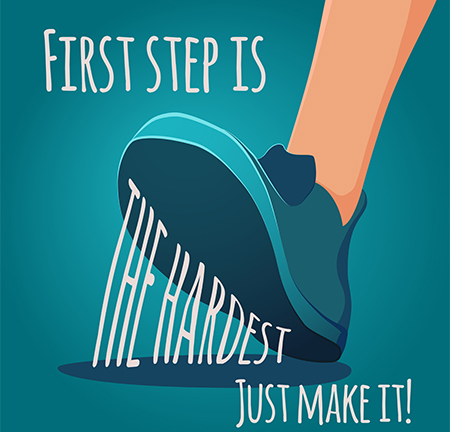 The pain never relents.
The pain never relents.
Mariana* experienced profound grief and loss within her family.
The weight of these losses left her insecure, uncertain, and struggling to trust that the people around her would stay.
Her painful past weighed heavily on her heart, hindering her ability to move forward and fully embrace life.
She was ready to try something new.
Seeking a path toward healing, Mariana decided to try working with a therapist who specialized in EMDR.
With a glimmer of hope in her eyes, Mariana embarked on a courageous journey of self-discovery and healing.
And that’s when her new life began.
 The first step is the hardest.
The first step is the hardest.
In her initial sessions, Mariana poured her heart out to her therapist, sharing the stories of her loved ones who were no longer present in her life. She spoke of the profound emptiness she felt and the fear that gripped her, causing her to doubt the stability of her relationships.
Mariana was guided to delve into the EMDR process. With closed eyes, she allowed herself to revisit memories and emotions associated with her losses while engaging in bilateral stimulation through eye movements.
During these sessions, Mariana experienced a whirlwind of emotions. Waves of grief and insecurity crashed upon her, threatening to engulf her in their depths. Yet, amid the storm, her therapist reassured her that healing was possible and that she was not alone on this journey.
Soon, she began to grow.
As the EMDR sessions continued, Mariana began to notice a subtle shift within. The weight of her grief started to lift, and a flicker of trust began to ignite within her soul. She recognized that her past losses did not define her worth and that not all relationships were destined to end in pain.
With each subsequent session, Mariana’s self-assurance and her ability to trust others deepened. The EMDR process allowed her to reprocess her grief and loss, transforming her perspective and replacing her insecurities with a newfound sense of stability and resilience.
As Mariana’s healing journey progressed, she discovered that she could cherish the memories of her loved ones while also embracing the present and future. She realized that the uncertainty she had once clung to no longer had a firm grip on her spirit.
 Now she has the tools to thrive.
Now she has the tools to thrive.
Mariana found the strength to build meaningful connections and cultivate trust in her relationships. She discovered that people could be sources of comfort and stability, and she no longer felt the need to guard herself against potential loss.
As Mariana reflected on her transformation, she felt renewed hope and purpose. Inspired by her own healing journey, she dedicated herself to helping others who had experienced similar losses and struggles.
Mariana’s story became a testament to the healing power of EMDR, illustrating that even in the face of profound grief, it is possible to find solace, trust, and a renewed zest for life.
*Name and story are composite narratives and do not reflect an actual client.
“EMDR is not a magic wand, but it is a powerful tool that can help you rewrite the story of your life.”
What is EMDR?
EMDR is a therapeutic technique developed by Dr. Francine Shapiro in the late 1980s. It is recognized as an effective treatment for post-traumatic stress disorder (PTSD) by various organizations, including the World Health Organization (WHO) and the American Psychiatric Association (APA).
EMDR integrates elements from different therapeutic modalities, including Cognitive-Behavioral Therapy (CBT), Psychodynamic Therapy, and Somatic Therapy.
The primary goal of EMDR is to alleviate emotional distress associated with traumatic memories or other disturbing life events. It does this by facilitating the processing of these memories and integrating them into a healthier, adaptive framework. EMDR works on the premise that unresolved traumatic experiences can become “stuck” or maladaptively stored in the brain, leading to psychological symptoms and distress.
 How does EMDR work?
How does EMDR work?
During an EMDR session, the therapist guides the individual through a series of procedures designed to access and process traumatic memories. The core component of EMDR involves bilateral stimulation, which can be achieved through eye movements, tapping, or auditory tones.
This bilateral stimulation is believed to stimulate the brain’s information-processing system, allowing traumatic memories to be reprocessed and integrated more adaptively.
The EMDR process typically involves eight stages to reach the goal of reprocessing the bothersome memory.
The first stage involves gathering history and identifying specific memories or events to target during the EMDR sessions. Next, it’s important to develop coping skills and relaxation techniques to be prepared to process distressing topics.
Some time will be spent on identifying specific aspects of the targeted memory, including the associated emotions, negative beliefs, and physical sensations. Then, the individual focuses on the targeted memory while simultaneously engaging in bilateral stimulation. This allows the distress associated with the memory to gradually reduce.
Positive beliefs and associations are strengthened, allowing the individual to replace negative beliefs with more adaptive ones. Next, I will guide the individual to scan their body for any remaining tension or distress. This step helps ensure that all aspects of the memory have been adequately processed.
Of course, we will ensure the individual is stable before the session ends. We may use self-calming techniques or strategies to manage potential distress between sessions. At the beginning of subsequent sessions, we will review the progress and determine the next steps of treatment.
“Through EMDR, we can turn wounds into wisdom and scars into sources of strength.”
Benefits of EMDR
By targeting the root cause of distressing symptoms, EMDR aims to alleviate emotional suffering and promote lasting healing. Many individuals report a significant reduction in distress and overall well-being after completing EMDR therapy.
The benefits of EMDR can vary from person to person, and individual experiences may differ. The effectiveness of EMDR also depends on factors such as the severity of the trauma, the individual’s readiness for therapy, and the quality of the therapeutic relationship.
Consulting with a qualified EMDR therapist can provide a better understanding of how EMDR may specifically benefit your unique situation.
Who can EMDR help?
Here are some groups of people who may benefit from EMDR:
- Individuals with Post-Traumatic Stress Disorder (PTSD): EMDR is recognized as an effective treatment for PTSD. It can help individuals who have experienced traumatic events such as accidents, natural disasters, physical or sexual assault, combat, or other life-threatening situations.
- Survivors of Childhood Trauma and Abuse: EMDR can be particularly helpful for individuals who have experienced childhood trauma, including emotional, physical, or sexual abuse. It can assist in processing and healing the effects of these early traumatic experiences.
- Those with Anxiety and Panic Disorders: EMDR has shown promise in alleviating symptoms of anxiety disorders and panic attacks. It can help individuals reduce anxiety, manage overwhelming emotions, and develop more effective coping strategies.
- People with Phobias and Fears: EMDR can benefit individuals struggling with specific phobias and irrational fears. It can help desensitize the distressing emotions associated with these phobias, reducing fear responses.
- Individuals with Depression: EMDR may provide relief for individuals experiencing depression, particularly when rooted in traumatic experiences. By addressing the underlying trauma and associated negative beliefs, EMDR can improve mood and overall well-being.
- Those with Grief and Loss: EMDR can assist individuals in processing grief and loss, including the death of a loved one, relationship breakups, or significant life changes. It can help individuals navigate complex emotions and facilitate the healing process.
- Survivors of Accidents and Natural Disasters: EMDR can aid individuals who have experienced accidents or natural disasters. It can help them process traumatic memories, reduce distressing symptoms, and promote resilience in the face of such events.
- People with Performance Anxiety or Trauma: EMDR has been used to address performance anxiety in various domains, such as sports, public speaking, or artistic performances. It can also help process traumatic experiences related to performance or public exposure.
Reach out now for a consultation to see if EMDR might be right for you.

